| Air Quality | Estate Greening and Landscaping | |||
| Noise Control | Waste Management | |||
| Energy | Water | |||
| Material Usage and Control of Hazardous Materials |

In the past year, the Housing Authority (HA) continued to enhance the building designs, and construction technologies of Public Rental Housing (PRH), and improve estate management and maintenance as well as implement stringent control on contractors so that the impact on the environment can be minimised. We encouraged residents and stakeholders joining us to save energy, reduce production of waste and promote recycling of waste, contributing to the sustainable development of Hong Kong.
During the year, we complied with all applicable environmental legislation. However, there were seven conviction cases in environmental offences regarding our contractors' operations. Two cases were related to air, waste and noise respectively and one case was related to water.
| Awareness Arising Targets for period 2007/08 | Progress |
| Review and monitor environmental awareness in Public Rental Housing by reviewing the need for surveys and providing the results to the related sections for necessary improvements. | Fully Met |
Air quality is currently one of the major concerns in the territory. The Housing Authority (HA) has implemented various improvement measures including installation of deodorisers in refuse collection points, introduction of "hard-paved construction" and speed control for construction vehicles at all building and piling sites, elimination of ozone depleting chemicals, etc., to reduce the impact of our operations on air quality.
Working for Better Air Quality
Besides our own efforts, we work closely with the community to improve air quality. We have rendered our full support to the "Better Air Quality Engagement Process" launched in June 2007 by the Council for Sustainable Development to collect valuable input from the community in formulating the clean air policy. A total of 680 000 Invitation and Response forms were distributed to our tenants to collect their views on ways to improve air quality in the following key areas:
- actions to be taken on high air pollution days;
- energy conservation or demand side management; and
- road pricing mechanisms.
The message of the survey was widely conveyed to our tenants and staff through our Housing Channel, roving exhibitions at ten Public Rental Housing estates and internal briefings and open forums. As a result, a total of 2 201 forms were received and 4 016 participants visited our exhibition booths. Two thousand giveaways were distributed to our tenants for the return of completed forms.
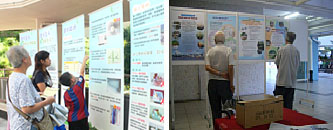 |
| Roving Exhibitions at Housing Estates |
To foster participation in the survey, we co-organised a competition with the Council for Sustainable Development for 135 Estate Management Advisory Committee (EMAC), which funded estates to award those with the highest response rate.
![]()
Estate Greening and Landscaping
Sustainable greening and landscaping provide residents a pleasant environment to live in. To build rich greening features and add novelty in our developments have always been our targets to enhance the quality of living environment for our residents. Substantial efforts were made in 2007/08 to provide green treatments for slopes in all of our new development projects. In addition, existing landscapes and slopes in the estates have also been improved by bringing in greening initiatives such as adding new vegetations, establishing new thematic gardens, hydro-seeding and re-landscaping.
| Greening and Landscaping Targets for period 2007/08 | Progress |
| Provide green treatment (e.g. hydro-seeding and tree planting) to newly formed slopes. | Fully Met |
| Add new vegetation and promote greening in new housing estates to meet the minimum target of one tree per 15 Public Rental Housing (PRH) flats. Conduct tree surveys to ensure that this is met. | Fully Met |
| Upgrade the existing landscape in 18 selected Public Rental Housing estates by improving soft landscaping through the Landscape Improvement Programme. | Fully Met |
| Promote a green environment at 24 estates with Estate Management Advisory Committee support through the provision of green activities in these estates. | Fully Met |
| Improve the slope appearance in existing Public Rental Housing estates by providing green treatment to hard surfaced slopes and improving on existing vegetated slopes. Also, chunam surfaces will be improved through hydro-seeding stone pitching and toe planters. | Fully Met |
| Enhance greening in Public Rental Housing estates by allocating open areas in selected estates for setting up theme gardens. | Fully Met |
| Increase tenants' awareness and support of green by organising tree planting days in selected estates. | Fully Met |
 |
| "Action Seedling" Community Participation Programme |
Promotion of Green Living Environment
The programme "Action Seeding" has been launched since June 2007, aiming to unify the inputs from our contractors, tenants and general community in bringing our new public housing estates to a greener living environment. Participants from residents, schools and community organisations were required to nurse seedlings plants given by the Housing Authority (HA) and its building contractors until they are fit for transplanting into the planters of new estates. We anticipate that a total of 14 new estates due for completion in the coming two years will benefit from this programme. This programme encourages Building Contractors to contribute actively towards community engagement, and fosters a greater sense of belonging and social responsibility among our contractors, residents and the community.
Landscape Development and Upgrading Existing Landscape Facilities
During the development and construction for new estates, we have carried out substantial landscape improvement works to maintain a better living environment. In 2007/08, all newly formed slopes and soil slopes, covering a total area of 870 square meters, were hydro-seeded and constructed with planters at toe and crest. In addition, we have also achieved our landscaping improvement target by planting at least one tree for every 15 Public Rental Housing (PRH) flats in all new housing estates.
In 2007/08, we have planted about 2 400 trees, 575 600 shrubs and 64 300 annuals in our estates and improved landscape design for 22 PRH estates, covering a total area of 116 000 square meters under the Landscape Improvement Programme. We have identified ten slopes in the existing PRH estates and provided green treatment to the hard surfaced slopes. For existing vegetated slopes and Chunam surface slopes, we also carried out hydro-seeding, stone pitching and toe planters for further improvement.
Thematic Gardens and Green Roofs
Greenery on rooftops can help insulate buildings, thus boosting energy efficiencies, a green neighbourhood as well as more relaxed and attractive surroundings. In Ching Ho Estate in Fanling which was completed in early 2008, we have provided planting on the rooftops of communal facilities (e.g. refuse collection point) and external walls, set up plants nurseries, and applied the use of Vertical Green Panels. We also completed the pilot scheme for green rooftops at Wo Lok Estate and are conducting the second pilot project in Fu Shan Estate.
To further enhance landscaping in PRH estates, we have chosen open areas in selected estates and set up thematic gardens, namely the Lagerstroemia Garden and Magnolia Garden at Wah Fu (I) Estate and Lung Hang Estate respectively.
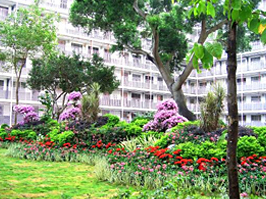 |
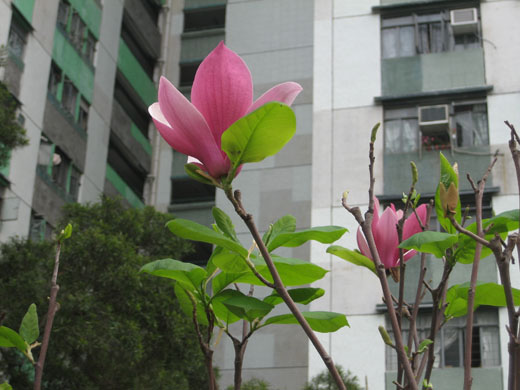 |
| Lagerstroemia Garden at Wah Fu (I) Estate | Magnolia Garden at Lung Hang Estate |
Greening Activities
To encourage greening in our PRH estates, we held the Housing Authority Flower Show bi-annually. In December 2007, the Flower Show was held at the Central Piazza of Kwai Chung Estate where more than 20 000 plants of over 40 species of flowers were artistically arranged and displayed.
 |
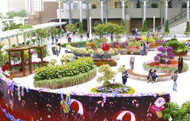 |
| Display in the Housing Authority Flower Show | |
To support the government initiatives, we have participated in the Leisure and Cultural Services Department's Hong Kong Flower Show 2008 by setting up a landscape garden that was designed around the idea of "Green Olympics". The display "Green Green Garden of Home" brought us for the second consecutive year the Gold Award for Design Excellence (Landscape Display). The barrier-free display of landscape design in the show demonstrated our green design concepts and efforts by exemplifying the application of greenery on rooftop, vertical green panel system and indoor greening to the public.
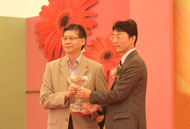 |
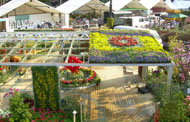 |
 |
| Award Presentation in the Hong Kong Flower Show 2008 |
Display in the Hong Kong Flower Show 2008 | |
As an environmentally responsible organisation, we maintain our dedication in providing a top quality living environment for our residents at all times. This year, we continued our on-going noise reduction measures by replacing noisy high speed water pumps in our Public Rental Housing (PRH) estates with quieter equipment, and using prefabricated building elements in our construction sites.
| Noise Targets for period 2007/08 | Progress |
| Reduce noise nuisance from water pumps in Public Rental Housing estates by replacing 3 000 rpm water pumps with 1 500 rpm water pumps. | Fully Met |
Noise Complaints and Abatement Notices
In 2007/08, we received nine noise complaints, six of which concerned construction sites. The rest were regarding noise generated during renovations. The noise complaints were recorded and properly addressed by the concerned contractors.
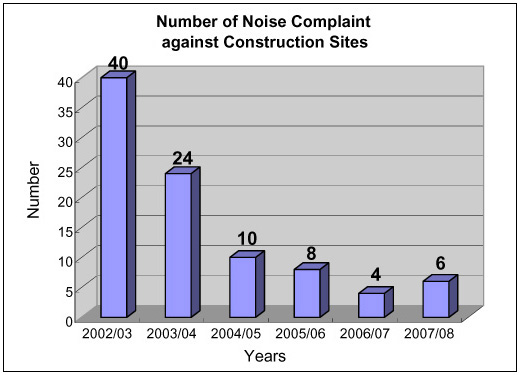
|
The number of noise abatement notices issued to public housing estates by the Environmental Protection Department has been very low in past years. This year, the HA achieved full legal compliance, the third consecutive year, as no noise abatement notices were received.
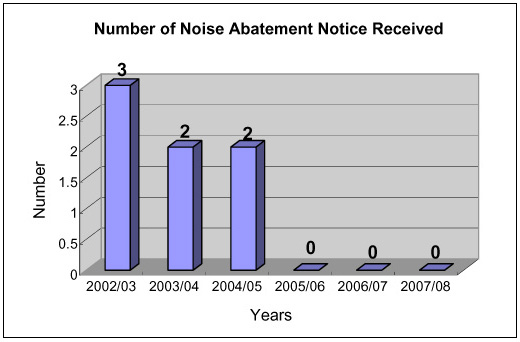
|
Water Pump Replacement
In 2007/08, a total of 18 high speed water pumps were replaced with low noise, low speed pumps in PRH estates to reduce noise pollution.
Noise Mitigation at Construction Sites
To reduce levels of construction noise, we continued to use hydraulic concrete crushers as opposed to percussive breakers in our demolition projects. For over 20 years we have been using prefabricated building structures such as precast facades, staircases and semi-precast slabs in our construction projects to cut noise generated by site activities. A new Enhanced Precast and Prefabrication System has been developed to further reduce the environmental impact of construction sites. In a pilot project using the enhanced prefabrication system, the scope of precast concrete works was extended from the usual rate of 20% to 60%. This decreased construction waste, noise and other nuisances for residents.
![]()
Hong Kong's thriving population and limited disposal facilities have created a tremendous waste disposal challenge. The per capita level of municipal solid waste disposal has risen from 1.28 kilogrammes per person per day in 1991 to 1.36 kilogrammes in 2007. The continued growth in waste load means Hong Kong will run out of landfill space far earlier than expected.
As one of the largest public agencies providing and managing housing facilities in Hong Kong, the Housing Authority (HA) always focuses on measures that support waste reduction and recycling.
| Waste Management Targets for period 2007/08 | Progress |
| Reduce construction and demolition (C&D) waste and ensure proper disposal by developing a Construction Waste Index through conducting surveys of C&D waste. | Fully Met |
| Increase domestic waste recovery rate for paper, aluminium cans, plastic bottles and used clothes by arranging publicity activities such as Waste Recycling Credit Scheme for all Public Rental Housing estates. | Fully Met |
| Promote waste reduction through various publicity campaigns with the aim to reduce generation of domestic waste. | Fully Met |
| Implement waste separation programme in all estates by phases. | Fully Met |
| Reduce A3 and A4 paper consumption in Housing Department offices by performing various initiatives to reduce paper consumption. | Fully Met |
| Collect waste paper in Housing Department offices and implement various initiatives to encourage paper recycling. | Fully Met |
| Use environmentally-friendly paper in printing of all publicity materials (except sales and marketing publication) by implementing its use as a pre-requisite in all printing jobs. | Fully Met |
| Enhance community awareness on environmental protection by launching campaigns to promote waste reduction and recycling in PRH estates and joint programmes with green groups and Estate Management Advisory Committees (EMACs), including distributing environmental publicity materials to tenants. | Fully Met |
Management of Construction and Demolition (C&D) Waste
The HA has taken the lead in managing disposal of construction waste. To reduce construction and demolition (C&D) waste in HA building contracts, we introduced a construction waste index (CWI) in 2004, which aimed to improve contractor C&D waste management practices and to evaluate the value of waste disposal schemes.
According to an on-going survey, our projects generate significantly less waste, some 30% less than similar private sector projects.
New Refuse Handling System
For effective waste handling, the HA has adopted a new refuse handling system for all new developments completed after October 2005. These include:
- installation of a 'Central Compactor System' for larger estate; or
- installation of a small scale 'Distributed Compactor System' for smaller estate.
The new refuse handling system reduces refuse volume for storage and to prevent odour leakage.
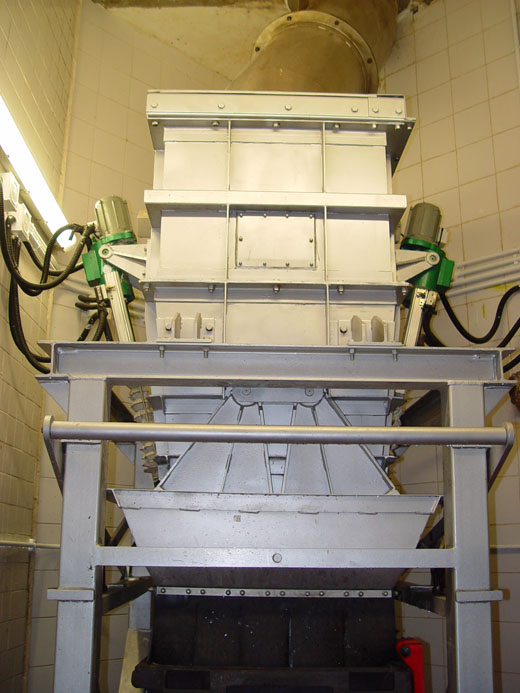 |
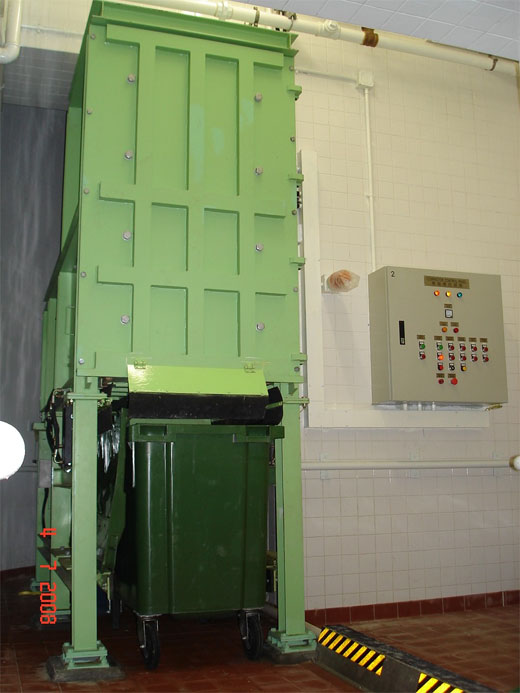 |
| Refuse Storage & Volume Control Device of a Central Compactor System |
Small Scale 'Distributed Compactor' |
Programme on Source Separation of Domestic Waste
To encourage more tenants to separate their waste for recycling, we implemented the Programme on Source Separation of Domestic Waste (SSW) in our Public Rental Housing (PRH) estates by phases in 2005.
In 2005/06 and 2006/07, a total of 60 PRH estates had participated in the SSW. In 2007/08, we involved another 30 PRH estates, for a total of 90 PRH estates participating in the programme. Floor-based waste separation facilities have been provided in the PRH blocks of participating estates to increase the rate of domestic waste recovery and reduce waste for disposal. In addition, seminars and briefings were held for participating PRH estates to enhance their awareness and encourage their participation in the SSW Programme.
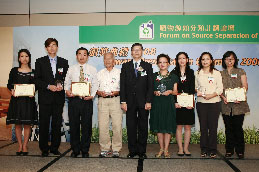 |
Source Separation of Domestic Waste Award-presentation Ceremony |
In view of the environmental benefits, the HA will introduce the SSW Programme in 30 PRH estates each year and plans to include all PRH estates in this meaningful programme by 2012.
During a presentation ceremony in August 2007, Kwong Fuk Estate won the Bronze Award for the SSW competition organised by the Environmental Protection Department (EPD), while 39 PRH estates received Certificates of Merit.
Domestic Waste Recovery
To enhance domestic waste recovery, in the past few years we have been setting waste reduction targets to recover four types of waste in PRH estates, namely paper, aluminium, plastic bottles and used clothes. In 2007/08, we worked with green groups to conduct a series of publicity activities at all PRH estates to convey green messages to our tenants and aim for an increase in waste recovery. Our achievements are highlighted below.
| Waste Type | Quantity of Waste Recovered (tonnes) |
Recovery Rate (%) | ||
| 2006/07 | 2007/08 | 2006/07 | 2007/08 | |
| Paper | 13 025.3 | 14 748.2 | 12.3% | 14.30% |
| Aluminium Cans | 267.7 | 309.6 | 28.3% | 32.31% |
| Plastic bottles | 503.3 | 764.6 | 6.2% | 9.48% |
| Used clothes | 561.5 | 632.7 | 6.8% | 12.68%* |
| * The increment in percentage is based on the comparison with the amount recovered (561.5 tonnes) in 2006/07. | ||||
In addition to these efforts, during the last Chinese New Year we have taken part in the EPD's programmes of recycling batteries and computers. We also participated in the tin box recycling campaign organised by the Friends of the Earth to collect more than 9 000 kilograms of biscuit and sweets tins, and 44 710 moon cake tins.
Domestic Refuse Production
After implementing various effective waste recovery initiatives, the average domestic waste production of our residents in 2007/08 was 0.7238 kg/person/day, a 1.59% reduction from the total domestic waste produced in 2006/07 or 11.7% reduction as compared with 2002/03.
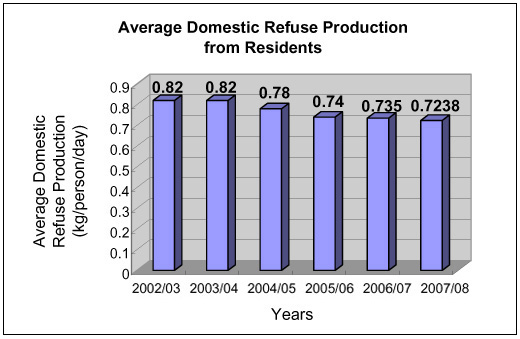
|
Reduction of Paper Usage in Office
To reduce paper usage, we have implemented various initiatives to collect waste paper and encourage paper recycling in all Housing Department (HD) offices. This year we had good achievements in reduction of paper consumption, with 134 892 reams of paper which represented 10.6% less than our target consumption rate set against the 2002/03 data. In addition, the quantity of waste paper collected in 2007/08 was about 8.8% and 3.3% higher than the collection rate in 2005/06 and 2006/07 respectively.
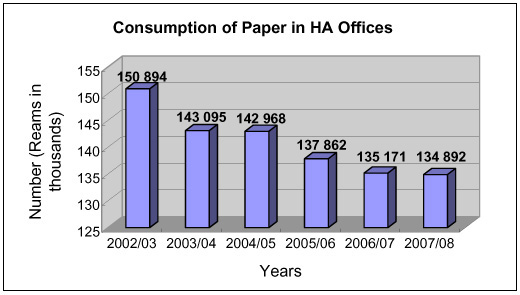 |
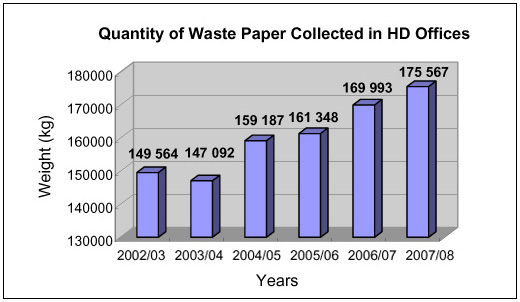 |
To further promote green initiatives, our offices have been encouraged to use environment- friendly paper as a prerequisite in all printing jobs.
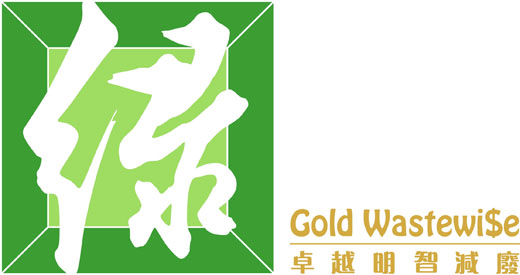 |
Wastewi$e Scheme
The EPD established the Wastewi$e Scheme to encourage and assist Hong Kong organisations in reducing the amount of solid waste generated during their operations. Each participating organisation had to set and meet a number of waste reduction targets and implement measures within a given time frame.
In the past six years, the HA has met the waste reduction targets and this year we have again received the Gold Wastewi$e Logo under the scheme.
Promotional Activities of Waste Recycling and Reduction
The success of waste recycling and reduction requires the full commitment and active participation of individuals interacting in our daily operations. These parties include residents, commercial and non-commercial tenants and even our staff. In 2007/08, we organised various activities to promote waste recycling and reduction in our offices and PRH estates, including:
- campaigns such as Estate Green Fun Day and Green Carnival to promote waste reduction and recycling;
- the "Green Delights in Estates" programme in association with green groups at 30 PRH estates;
- used book reselling activities to enhance staff awareness on saving paper; and,
- a tree planting event and display of information on "Global Warming" on World Environment Day to convey the message and provide tips on waste management.
We believe that energy conservation is a crucial element in sustainable development and helps combat global warming. We also believe that better management of energy use, effective energy reduction measures, and a commitment to save energy from individuals in the community will lead us to ultimate success.
| Energy Targets for period 2007/08 | Progress |
| Reduce electricity consumption of landlord services installation in new domestic blocks by adopting Energy Codes and obtaining energy certificates for completed projects. | Fully Met |
| Explore and study application of more energy efficient equipment by completing trial installation of solar powered lamp poles, adjustment of lift counterweight settings and adopting a wider use of T5 fluorescent tubes. | Fully Met |
| Reduce energy consumption of office premises by performing various energy saving initiatives. | Fully Met |
| Explore and study application of green design for building services equipment. | Fully Met |
Energy Consumption
In 2007/08, electricity consumption for our headquarters, offices and other premises was
620 226 167 kWh, a reduction of 3.69% from the electricity consumed in 2006/07. This accounts for a reduction of over 16 600 tonnes of greenhouse gas emissions1 and monetary savings of HK$ 23 million.
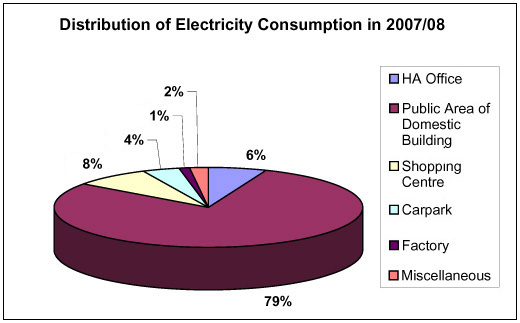 |
Public areas of domestic buildings in our estates represent the highest portion (about 79%) of the HA's annual electricity consumption. In 2007/08, the total electricity consumption of the public areas for domestic buildings was 494 117 110 kWh, about 2.9 % less than the electricity consumption of domestic flats in 2006/07. This contributes to a reduction of over
10 400 tonnes of greenhouse gas emissions and savings of HK$ 14 million.
The electricity consumption of public areas in 2007/08 was 69.4 kWh per flat per month, similar to 2006/07 levels.
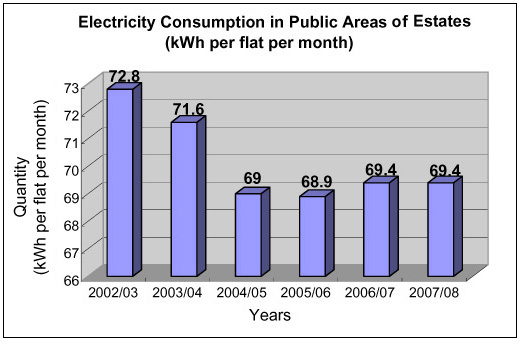 |
Since 2003 we have achieved our annual electricity savings target. In 2007/08, we recorded about 4.6% reduction from 2006/07 in the total electricity use of our offices. This decrease of
1 843 364 kWh is equivalent to a reduction of over 1 290 tonnes of greenhouse gas emissions and monetary savings of HK$ 1.84 million.
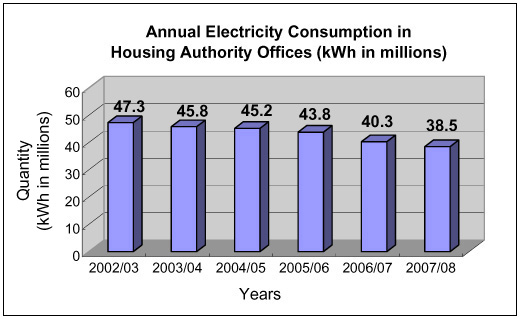 |
Fuel consumption of the HA's vehicle fleet during the year was 93 971 litres, a reduction of 6.66% compared with the fuel consumed in 2006/07. This accounts for a reduction of about 16 metric tonnes of carbon dioxide emissions2 to the atmosphere.
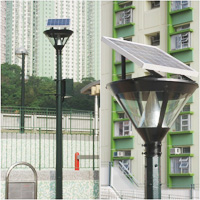 |
| PV Pole Lamp |
Energy Conservation
The Housing Authority (HA) always considers to introduce energy saving initiatives for our new development and construction projects. To explore the application of green design for building services equipment, a solar photovoltaic (PV) power system had been incorporated into the design of the redevelopment project of Lam Tin Phase 7 and 8 in 2006. The proposed PV power system is under construction and will be completed in early 2009. A monitoring programme has also been established to evaluate the operating and energy-saving performance for this renewable power system.
A pilot study had been carried out at Yau Lai Estate to determine energy saving potentials that can be employed during lift operation. The pilot test involved adjusting and optimising the counterweight settings for lift operation, and monitoring of energy saving potentials.
We have been adopting Building Environmental Assessment Method (BEAM) as a management tool to evaluate energy efficiency of our designs in various development projects. In addition, to ensure the awareness of energy conscious design in buildings, all of our development projects complied with the Building Energy Standards and Codes.
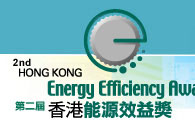 |
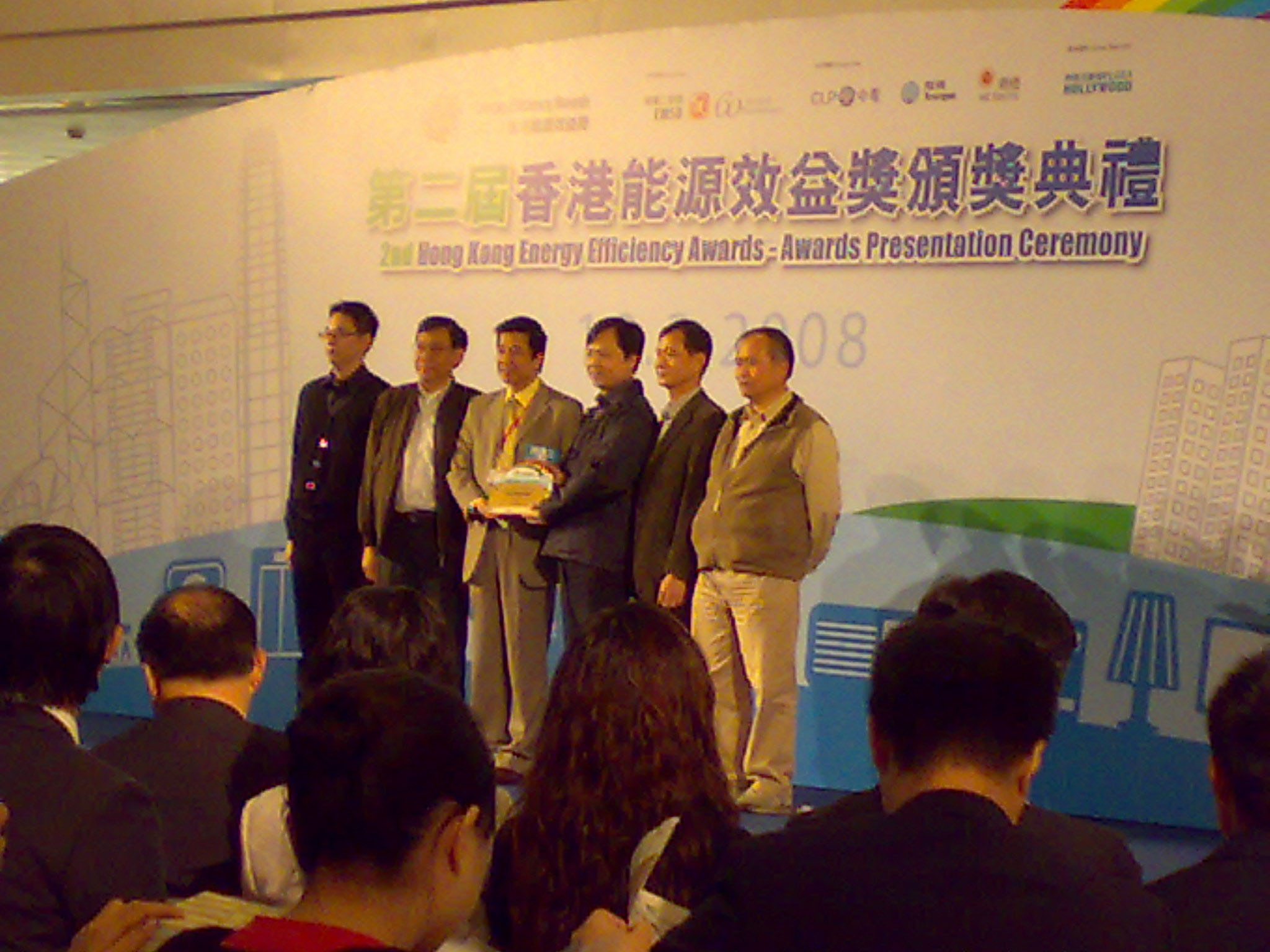 |
| "Hong Kong Energy Efficiency Awards" - Award-presenting ceremony |
To recognise our efforts in promoting energy efficiency for residential buildings, 24 of our estates took part in the competition of the second "Hong Kong Energy Efficiency Awards" organised by the Electrical and Mechanical Services Department (EMSD). This year, Ngau Tau Kok and Sau Mau Ping Estates won the Bronze Award in this competition while Shek Yam and Ting Heng Estate received the Merit Awards.
In early 2007, we launched a trial scheme on lighting device energy conservation in Homantin Estate. Preliminary results indicate a monthly saving of about 11% in power consumption for the public areas of the housing blocks. The HA has also extended the trial scheme on lighting device energy conservation to 10 other estates to allow the energy-saving measures to be further tested and assessed.
Footnote:
1. A default value for the emission factor of 0.7kg/kWh is employed to account for Green House Gas (GHG) emission associated generation of electricity to supply customers in Hong Kong (Source: Guidelines to Account and Report Greenhouse Gas Emissions and Removals for Buildings of Commercial, Residential or Institutional Purpose in Hong Kong)
2. Carbon dioxide emission is calculated using mobile combustion carbon dioxide emissions calculation tool version 1.3 developed by GHG Protocol Initiative. Assuming only gasoline is consumed by the HA's vehicle fleet, CO2 emission = GJ energy (Gasoline used in litre x 0.0344 GJ/unit) x Emission Factor (69.250 kg CO2/GJ)
![]()
Provision of a reliable and safe water supply system to Public Rental Housing (PRH) estates has always been a prime concern of the Housing Authority (HA). To achieve this ever challenging task, the HA strives to ensure a continuous high quality water supply service.
In 2007/08, the HA has practiced various measures to use water in a more efficient and environmentally sensible manner.
Each year the HA sets water conservation targets and uses different initiatives to achieve continuous improvement in water consumption and water quality.
| Water Conservation Targets for period 2007/08 | Progress |
| Reduce flushing water consumption by conducting trial schemes in new projects, i.e. pilot project Shek Lei Phase 10 and conducting performance reviews. | Fully Met |
| Reduce potable water consumption for installations under landlord control in Public Rental Housing estates by using self-stopping water taps and conducting re-plumbing programmes to minimise pipe bursting and leakage as well as studying the feasibility of using rain water for plant watering and general cleaning. | Fully Met |
| Continue to reduce water consumption at HA Headquarters by performing water saving initiatives as appropriate. | Fell Short* |
* The water consumption in 2007/008 (i.e. 15 285m3) reduced by 2.1% when compared with the water consumed in 2006/07 (i.e. 15 618 m3) but exceeded the target for 2007/08 (i.e. 15 000 m3) by 1.9%. |
|
Reduce Flushing Water Consumption
Since 2003, dual-flush cisterns have been installed in the washrooms at HA Headquarters to test their water saving potential, durability and maintenance requirements.
In view of the trial's positive results, we extended this green initiative through a pilot project that installed dual-flush cisterns in the development of Shek Lei Phase 10.
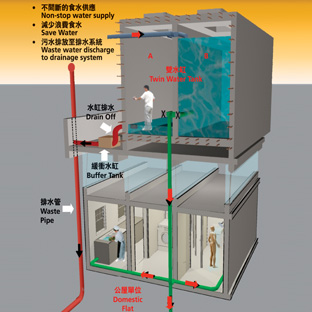 |
| Schematic of Twin Water Tanks |
Twin Water Tanks Installation
We plan to adopt twin water tanks at all new PRH blocks to be completed from mid-2009 onwards. The primary purpose of twin tanks is to provide an uninterrupted water supply to tenants. Twin water tanks allow one tank to remain in service while the other is being cleaned or maintained. This innovative design not only reduces water wastage during maintenance or cleaning, but also improves the durability of the building's roof structure.
To reduce potable water consumption in PRH estates the HA has introduced self-stopping taps in various PRH estate facilities. To further enhance potable water usage, in 2006/07 we implemented a 3-year re-pumping programme which aimed to reduce pipe bursts and leakage. In 2007/08 we achieved a reduction of 1.6 % in water consumption, which fully met our performance target.
![]()
Material Usage and Control of Hazardous Materials
The following targets have been set for material usage and control of hazardous materials.
| Material Usage and Control of Hazardous Materials for period 2007/08 | Progress |
| Use softwood timber doors in Public Rental Housing estates. | Fully Met |
| Abate the remaining asbestos containing materials in existing HA managed properties. | Fell Short* |
* Refer to the Asbestos Abatement Programme |
|
|
|
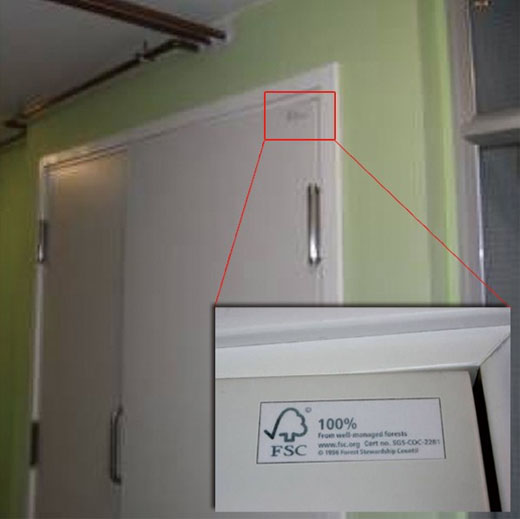 |
| Softwood Timber Doors Installed in PRH Estates |
Use Softwood Timber Door in PRH Estates
In 2007/08, we carried on with a pilot project using softwood timber doors in the construction of Eastern Harbour Crossing Phase 4 (EHC4). These doors were made of timber from sustainably managed forests and with the certification of the Forestry Stewardship Council (FSC). The results of using softwood timber doors, together with the quality assurance and traceability issues of using FSC products, are currently under review by the EHC4 project team.
Contractors have been encouraged and assisted by the Housing Authority (HA) to use reusable metal hoardings, metal formwork and prefabricated building elements. We have estimated that our construction projects avoided using 16 640 tonnes of timber.
Pulverised fuel ash (PFA) has been used as a partial cement substitute on our construction sites. It is estimated that during 2007/08 the substitution of PFA saved 12 800 tonnes of cement.
Asbestos Abatement Programme
In 2007/08, we implemented an asbestos abatement programme through the estate redevelopment programme and asbestos removal works to remove the remaining asbestos containing materials in existing HA managed properties. This year the asbestos removal percentage was 2.2%, which fell short of our target of 3.4 %. The main reason for not meeting our target was due to a delay in tendering demolition for the redevelopment of Wong Chuk Hang Estate Phases 2 & 3.
![]()